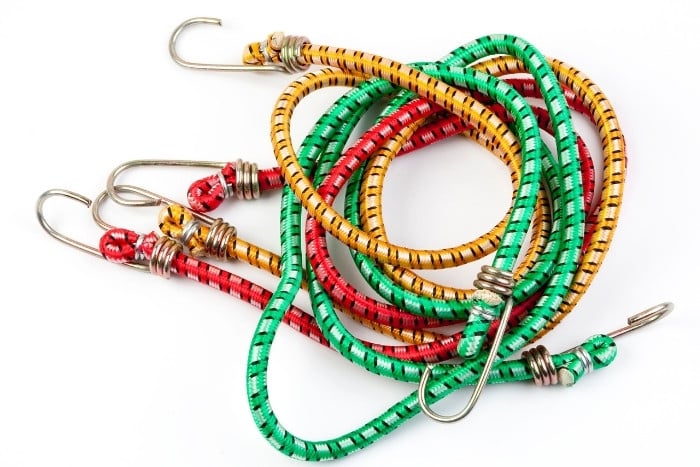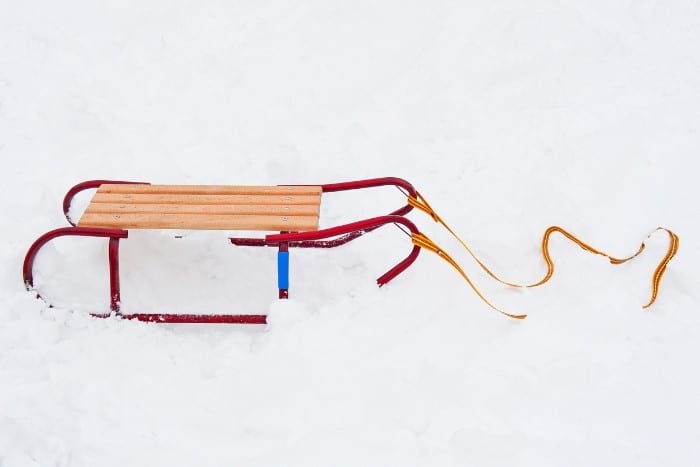Some of the best areas for ice fishing aren’t reachable by car or truck. As a result, you will have to use a sled to carry all the gear you need. It could be early in the season or way off the beaten path, and walking is the only option to get to that perfect spot.
You can use a regular sled to carry your ice fishing gear. However, standard sleds usually have pretty low sides, so gear can easily fall out of them. Plus, they’re not always rated for a large amount of weight, but you’re able to use a regular sled for ice fishing if absolutely necessary.
While a regular sled isn’t the most convenient, it’ll do the job.
How To Use Regular Sleds for Ice Fishing?
If you live in an area with hills, cold weather, and snow, you likely have some sort of sled sitting in the garage.
They’re made of plastic and are usually able to withstand freezing temperatures and harsh conditions. Regular sleds don’t only have to be used for sliding down snowy hills.
They can carry your ice fishing gear as well. You’ll create the ideal ice fishing sled setup with a few modifications.
1. Use Bungee Cords To Secure Your Gear
A quick look at your “regular” sled will likely give you some immediate questions about how to transfer your expensive and heavy ice fishing gear across bumpy and rough snow and ice.
While ordinary sleds do have sides for people to hold on to when they’re sliding down hills, they are only a few inches high and aren’t going to prevent stacked ice fishing gear from falling off the side.
One tight turn or ice patch will cause all your equipment to dump, which can be highly frustrating, especially if you must travel several hundred yards to get to your fishing spot.
When you load your gear (ice house, auger, rods, tackle, heater, etc.), ensure you have half a dozen bungee cords on hand. Get everything in place and attach bungee cords to the sides.
Usually, anyone riding in the sled would use a one-inch wide section of plastic as a handle, making for a perfect attachment point for the bungee cords.

2. Load Heavy Gear on the Bottom of the Sled
Odds are, you’re probably carrying some shelter, auger, heater, and other gear to your spot.
To ensure that you’re not going to dump your equipment as soon as you hit the ice, load all your heaviest equipment on the bottom. This method keeps everything in place as you walk out on the snow and ice.
You can place some of your lighter gear on top and then secure it all before you begin your journey.
Test how it pulls across the snow with your heaviest equipment and then add more to the load to see if it can handle the extra weight.
3. Use the Proper Rope
You need a solid rope that won’t snap when pulling your gear. A regular sled’s rope is likely very thin and not very strong. If possible, switch the rope from the sled to something more substantial.
A 9.5mm or 10mm rope is strong enough to ensure that you can pull your sled through slush and heavy snow.
Some anglers choose to make backpack straps out of the rope so they don’t have to grip it with their hands as they’re pulling it.
Adding extra rope at the end to allow you to use your body weight as you drag across the snow and ice makes the entire process much more manageable.
It doesn’t have to be backpack straps. A simple loop that can fit over your torso will do the trick.

4. Purchase Runners
If you look at the bottom of your sled, you’ll notice that vertical indents run up and down your sled. These aren’t very effective if you’re trying to pull the sled over slush, ice, and other snow.
The indents will collect excess snow and cause you to have to pull harder and slow down as you’re walking. You don’t need the sled to grip as tightly on the snow as you try to drag it to your fishing spot.
Runners will fill in the gaps in the sled that are usually used for friction and traction.
Not only will these help you slide along the ice better, but they’ll also reduce the wear and tear you get on the bottom of your sled.
Runners can take a normal, regular sled and turn it into a great ice fishing sled. Some people even use cross-country skis and attach them to the bottom of their sled.
If you have some extra lying around, then it’s worth giving them a try.
5. Know Its Limits
Regular sleds are not built quite like an ice fishing sled. Ice fishing sleds are a quarter-inch to half-inch thick and are built to carry heavy loads and pull across ice and snow.
Ordinary sleds are not this thick. They’re meant to go down hills quickly and create as little friction as possible.
If you’re using a regular sled, it’ll be able to carry up to a couple hundred pounds, but it’s not going to be as efficient as an ice fishing sled. It’s likely lighter and far more flimsy than ice fishing sleds.
The first area you’ll find that fails on a regular sled is the area where the rope is attached. The hole holding the rope is likely very close to the sled’s edge, where the plastic is the weakest.
One strong jerk on the rope can rip right through the plastic if it’s weighed down too heavily with your gear. So, keep this in mind especially if you happen to get stuck.
Don’t expect to carry an entire ice house, your auger, heater, propane, and all your other accessories on one single regular sled.
You may be able to get your house, auger and heater, but you’ll likely have to carry the rest of your gear or use a second regular sled.
Also, regular sleds are generally a bit skinnier than an ice fishing sled. The skinnier the sled, the easier it is going to tip over.
Make sure you pick a well-used path or be prepared to pick up your tipped over sled. It also helps to ensure your rope is situated directly at the sled’s center so you aren’t continually pulling at an angle.
Conclusion
Regular sleds can work to haul your ice fishing gear if you’re trying to save money or are short on time. No, they’re not the strongest or most efficient option, but they do work.
Take some extra precautions to load your heaviest gear on the bottom and secure it with some bungee cords.
This effort will give you peace of mind that your sled and gear can withstand some rough terrain without dumping everything all over the ice.
Once we get to the water, we want to go fishing as soon as possible. If you can’t drive to the spot, yours or your kids’ sled will do the trick.
